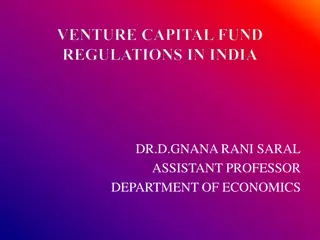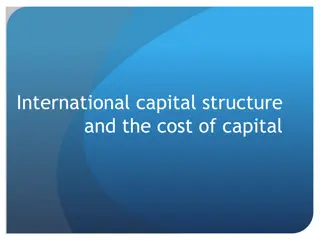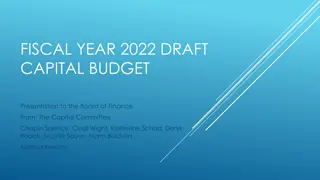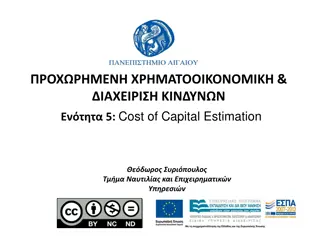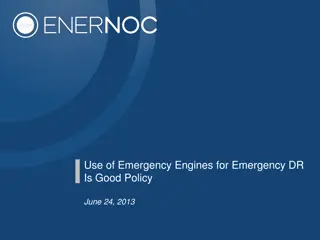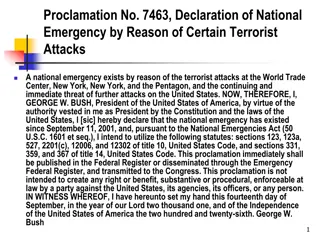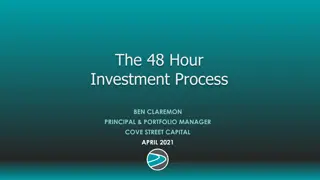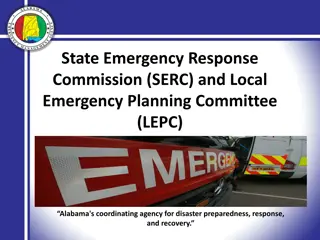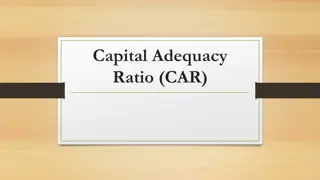Overview of Emergency Capital Investment Program (ECIP)
The Emergency Capital Investment Program (ECIP) is a government initiative providing direct investments to Community Development Financial Institutions (CDFIs) and Minority Depository Institutions (MDIs) to support low and moderate-income communities disproportionately impacted by the COVID-19 pandemic. With an emphasis on lending, grants, and forbearance, ECIP aims to aid in economic recovery. The program timeline, investment structure, key terms, and compliance details are outlined, highlighting the impact and initiatives undertaken.
- Government Initiative
- Financial Inclusion
- Community Development
- Investment Program
- Economic Recovery
Download Presentation

Please find below an Image/Link to download the presentation.
The content on the website is provided AS IS for your information and personal use only. It may not be sold, licensed, or shared on other websites without obtaining consent from the author. Download presentation by click this link. If you encounter any issues during the download, it is possible that the publisher has removed the file from their server.
E N D
Presentation Transcript
Emergency Capital Investment Program Presenters Steve Davidson ECIP Investment Director U.S. Department of the Treasury Carol Rodrigues Office of the General Counsel U.S. Department of the Treasury February 2022 1
Emergency Capital Investment Program Topics Background Investment Structure and Key Terms Dividends and Interest Qualified and Deep Impact Lending Initial Supplemental Report Next Steps 2
Emergency Capital Investment Program Background Investment Structure and Key Terms Dividends and Interest Qualified and Deep Impact Lending Initial Supplemental Report Next Steps 3
Emergency Capital Investment Program Background Consolidated Appropriations Act, 2021 provided $9 billion for the Emergency Capital Investment Program (ECIP) Provides direct investments into Community Development Financial Institution (CDFI) and Minority Depository Institution (MDI) banks, credit unions and holding companies. The investments are to support the efforts of CDFIs and MDIs to provide loans, grants, and forbearance to low and moderate income (LMI) and minority individuals and communities. The ECIP design places an emphasis on communities disproportionately impacted by the COVID-19 pandemic. 4
Emergency Capital Investment Program Background Cont d ECIP Timeline December 27, 2020: Treasury is authorized to establish ECIP by the Consolidated Appropriations Act of 2021. September 1, 2021: Application deadline. Treasury received 204 applications from financial institutions. February 15, 2022: Treasury published draft Initial Supplemental Report forms and instructions for review and comment. Starting in January 2022: Treasury began closing and funding process. August 11, 2021: Treasury publishes ECIP program update and extends application deadline to September 1, 2021. December 14, 2021: Treasury announced it was approving investments in 186 institutions. February 2, 2022: Treasury released preview copies of transaction documents . 5
Emergency Capital Investment Program Background Investment Structure and Key Terms Compliance Dividends and Interest Qualified and Deep Impact Lending Next Steps 6
Emergency Capital Investment Program Investment Structure Investment limits Amount per issuer cannot exceed $250 million and is limited to: 7.5% of total assets for institutions with > $2 billion in total assets 15% of total assets for institutions with $500 million to $2 billion 22.5% of total assets for institutions with < $500 million in assets Form of Investment Treasury will purchase senior perpetual preferred stock, or if an eligible institution cannot feasibly issue preferred stock (e.g., Subchapter S corporations, mutuals and credit unions),Treasury will purchase subordinated debt. Institutions will execute a purchase agreement, letter agreement, investment instrument, and other closing documentation, as applicable, with Treasury. 7
Emergency Capital Investment Program Investment Terms Term Sheets for ECIP instruments: Senior Preferred Stock Term Sheet Subordinated Debt Term Sheet (Mutuals and S Corps) Credit Union Subordinated Debt Term Sheet 8
Emergency Capital Investment Program Legal Agreements Three sets of agreements: 1. Institutions that can issue preferred stock; 2. Credit unions, which will be issuing subordinated debt; and 3. Mutuals or S-Corps, which will be issuing subordinated debt. Each set of agreements has three documents: 1. Securities Purchase Agreement (SPA), which contains most of the main terms; 2. The form of security, which is the Certificate of Designations in the preferred stock documents and the Form of Subordinated Security in the subordinated debt documents; and 3. Letter Agreement. The Letter Agreement contains details about the recipient; details about the instruments; the closing date; and various schedules allowing the recipient to disclose certain material items, such as ongoing litigation or regulatory agreements. The Letter Agreement incorporates by reference the SPA and the form of security. The Letter Agreement is the only document that will be signed by Treasury and the recipient. The agreements are modeled very closely on the agreements that were used for prior similar Treasury programs, including the Small Business Lending Fund. 9
Emergency Capital Investment Program Preferred Stock Investment Terms Senior, non-cumulative, and perpetual non-voting preferred Dividends do not accrue and are not payable for the first 2 years. The dividend rate adjusts for years 3-10 depending on the previous year s level of qualified and deep impact lending, as described in the Rate Reduction Incentive Guidelines. After year 10, the dividend rate will convert to a fixed rate based on the average annual increase in qualified lending over the baseline during years 2 through 10 (an average of 9 years). Tier 1 capital treatment. 86 FR 15076 (Mar. 22, 2021). 10
Emergency Capital Investment Program Subordinated Debt Investment Terms Unsecured debt, with a 15- or 30-year maturity option. All debt from the same issuer must carry the same maturity. Maximum interest rate is 2 percent. Interest does not accrue and is not payable for the first 2 years. Interest rate adjusts for years 3-10 depending on the previous year s level of qualified and deep impact lending, as described in the Rate Reduction Incentive Guidelines. After year 10, the interest rate will convert to a fixed rate based on the average annual increase in qualified lending over the baseline during years 2 through 10 (an average of 9 years). Tier 2 capital treatment. 86 FR 15076 (Mar. 22, 2021). 11
Emergency Capital Investment Program Investment Transfers Treasury Transfer Restrictions Issuer shall have a right of first refusal to buy back the investment under terms that do not exceed a value determined by an independent third party (conditional upon regulator approval); Treasury will not sell more than 25% of the equity/interests of an issuer to a single third party without the issuer s consent; With the permission of the issuer, Treasury may transfer or sell the investment to a mission aligned nonprofit affiliate of an applicant that is an insured CDFI ( Eligible Nonprofit ); and Treasury will not sell the investment (other than to an Eligible Nonprofit) before the tenth anniversary of the investment date without the issuer s consent, which is not to be unreasonably withheld. In addition, Treasury will commit to an 18-month advance notice of intent to transfer the investment other than to an Eligible Nonprofit. Issuer Transfer Restrictions The issuer may merge or sell all, or substantially all, of its assets, provided that the right of the investment interests and obligations are assumed and equivalent investment interests are issued by the successor if applicable. The successor must also meet either the certified CDFI or MDI criteria to continue to participate in the ECIP unless prior Treasury approval is obtained. 12
Emergency Capital Investment Program Closing Conditions Most of the closing conditions are market standard for this type of instrument, including delivering certificates of good standing and incumbency certificates. Two closing conditions specific to ECIP: Recipient must submit the Initial Supplemental Report at least 10 business days prior to Closing. This report is what is used to calculate the baseline level of qualified lending that is used to calculate the rate reduction. Recipient must deliver an Emergency Investment Lending Plan that describes to the satisfaction of [Treasury] the elements of the lending plan set out in the ECIP statute. 13
Emergency Capital Investment Program Representations and Covenants The recipient will need to represent that they are eligible to participate in the ECIP. Many of the covenants are market standard, including making commercially reasonable efforts to consummate the transaction. Some ECIP-specific ones are noted below: The recipient will need to provide periodic certifications and submit quarterly supplemental reports on its qualified lending. The recipient will comply with the restrictions in the ECIP Interim Final Rule. If the recipient is a CDFI, it will not revoke or change its status as a CDFI or permit its status as a CDFI to be changed. 14
Emergency Capital Investment Program Remedies Treasury s remedies upon a breach of the Agreement, the ECIP statute or any ECIP regulations (a breach) are set out in Article V. All of the remedies are at Treasury s discretion. A breach may reset the payment rate to 2%. A breach may be reported to the CDFI Fund and may make the recipient ineligible for CDFI Fund awards or other Treasury programs. A breach would allow Treasury to sell the instruments before the end of the 10-year period and without giving 18 months of advance notice, subject to the other restrictions on transferability that are in the ECIP statute (i.e., Treasury would still need to provide a right of first refusal etc.) Treasury can propose additional remedies. The recipient agrees that enforcement of the provisions of the agreements and the ECIP Interim Final Rule are subject to 12 U.S.C. 4717 and Treasury may inform the federal banking regulators of any noncompliance. 15
Emergency Capital Investment Program Background Investment Structure and Key Terms Dividends and Interest Qualified and Deep Impact Lending Initial Supplemental Report Next Steps 16
Emergency Capital Investment Program Calculation Payment Interest and dividends are paid quarterly on fixed dates. No interest or dividends accrue for the first two years. After that, the rate is a maximum of 2%, but may be reduced based on the increase in qualified lending over the baseline. The rate resets annually for years 3-10 of the investment and is then fixed based on the average increase in qualified lending over the preceding nine years. Calculation The quarterly supplemental reports will be used to calculate the increase in qualified lending over the baseline and the applicable payment rate. 17
Emergency Capital Investment Program Deferral Deferral Preferred stock dividends are non-cumulative. For subordinated debt, payment deferral is available in any quarter where the institution fails to be well capitalized, fails to achieve positive net income, or gives notice that payment would be detrimental to the financial health of the institution. Payments may resume the next payment period. If dividends or interest are not declared or not paid, the CEO and CFO must provide written notice to Treasury and include the rationale for why dividends were not declared or paid. 18
Emergency Capital Investment Program Non-payment Remedies upon Non-payment Recipient cannot make capital distributions on securities that are junior or pari passu to the ECIP instruments until dividends or accrued interest on the ECIP instruments have been paid in full. Credit unions also cannot issue extraordinary or special dividends on share accounts until accrued interest on the ECIP instruments has been paid in full. If five dividends or interest payments have not been paid in full, Treasury can appoint a non-voting observer to the recipient s board. For the preferred stock and mutuals/S-corps, if six dividends or interest payments have not been paid in full, Treasury can elect two directors to the recipient s board. 19
Emergency Capital Investment Program Background Investment Structure and Key Terms Dividends and Interest Qualified and Deep Impact Lending Initial Supplemental Report Next Steps 20
Emergency Capital Investment Program Qualified Lending Target Community People Qualified Lending Deep Impact Lending LMI borrowers Other Targeted Population borrowers Low Income Borrowers Mortgage Lending to Other Targeted Populations Places Rural Communities Urban Low-Income Communities Underserved Communities Minority Communities Small Business or Farms Persistent Poverty Counties Indian Reservation Native Hawaiian Homelands U.S. Territories Small Businesses with revenues that do not exceed $100,000 Businesses majority owned by low-income individuals or Other Targeted Populations Businesses Projects Affordable Housing Public Welfare Investments that primarily benefit LMI individuals and communities Community Service Facilities Deeply Affordable Housing Public Welfare Investments that primarily benefit low- income individuals or minority individuals or businesses. 21
Emergency Capital Investment Program Rate Reductions To set payment rates after year 2, Treasury will compare increases in qualified lending and deep impact lending to the amount of qualified lending in the 12 months ending September 30, 2020. 2% maximum dividend / interest rates but with reductions can go as low as: 1.25% if the institution increases its qualified lending by 200% to 400% of the amount of Treasury investment 0.5% if the institution increases its qualified lending by more than 400% of the amount of Treasury investment Deep Impact Lending will receive double credit towards an institution s dividend or interest rate reduction. 22
Emergency Capital Investment Program Background Investment Structure and Key Terms Dividends and Interest Qualified and Deep Impact Lending Initial Supplemental Report Next Steps 23
Emergency Capital Investment Program Initial Supplemental Report Establishes the baseline amount of Qualified Lending by an Applicant, which will be used to measure increases in Qualified Lending in subsequent years during the ECIP investment period. The baseline is established by measuring the amount of Qualified Lending during the baseline year, which is the one-year period ending on September 30, 2020. Due to Treasury 10 business days before the Applicant s closing date. Two components: 1. Schedule A - Summary report to collect baseline period origination data. Purpose: Establish the baseline in order to calculate growth in Qualified Lending to determine rate reduction. 2. Schedule B - Disaggregated report to better understand Qualified Lending and Deep Impact Lending by Target Community. Purpose: Provide a snapshot of the composition of the baseline origination activity, to allow Treasury to better understand program impact. Initial Supplemental Report forms and instructions are in draft form and were posted to the Treasury website for public comment. Comments are due Monday, February 28. 24
Emergency Capital Investment Program Templates and Instructions Two sets of forms and instructions: one for IDIs and holding companies, and one for credit unions. Report submitted through the ECIP Portal. Each schedule has a spreadsheet template. Applicants will download a pre-formatted excel file, input their data into the excel file, upload the file, and certify accuracy of the report. Instructions provide guidance on how to submit the report, the contents of the report, and line-item instructions for each line of the schedules. Applicants are asked to provide a narrative explanation of the methodology used to generate the data in the report. 25
Emergency Capital Investment Program Lending Activity Reports are organized based on items in the Call Report to facilitate categorization of loans. The Initial Supplemental Report measures loan originations and certain investments, not balance sheet values. Do not report balances from the Call Report. Qualified Lending is lending that can be identified as having been made to a Target Community listed on the previous slide. The Glossary provides further details on the Target Communities. For certain place-based communities, Treasury will post lists of communities that meet the definition or will provide links to other databases that can be used, such as FFIEC or CDFI Fund data sets. 26
Emergency Capital Investment Program Schedule A Measures the baseline amount of Qualified Lending that will be used to calculate rate reductions. Identify Qualified Lending without double counting. Qualified Lending and Deep Impact Lending count equally for the baseline. Report the number of loan originations and investments and the dollar value. Baseline is subject to a floor and ceiling. The floor is based on lending reported by the Applicant for fiscal year 2020 in Question 1(a) in the Institution s Emergency Investment Lending Plan. Ceiling is total originations. 27
Emergency Capital Investment Program Schedule B Presents disaggregated data on Qualified Lending. Schedule B is not used to calculate rate reductions. Identify Qualified Lending and Deep Impact Lending to each Target Community. Treasury expects there may be double countingand that values in Schedule B will not sum to values in Schedule A. 28
Emergency Capital Investment Program CDFI Loan Funds Lending Activity includes purchases of or participations in loans during the baseline year made by non-depository CDFI loan funds that were originated within one year of purchase by the Applicant. Only eligible to qualify as Qualified Lending or Deep Impact Lending if the underlying loan is made to a Target Community listed in the table. In Schedule B, include as Deep Impact Lending purchases of or participations in loans during the baseline year made by non-profit non-depository CDFI loan funds that were originated within one year of purchase by the institution AND that were made to a Target Community listed under Deep Impact Lending in the table (e.g., Persistent Poverty Counties). Purchases of or participations in loans during the baseline year made by for-profit non-depository CDFI loan funds may only be included as Qualified Lending and not Deep Impact Lending even if they were made to a Target Community listed under Deep Impact Lending in the table. 29
Emergency Capital Investment Program Comments Draft ISR Open for Comment Treasury welcomes comments regarding the draft Initial Supplemental Report forms and instructions. Treasury welcomes comments on the estimated burden, time, and cost to complete the reports. Submit comments and questions regarding these drafts by emailing ECIP@treasury.gov. For more information, see the Reporting Resources section on the ECIP webpage. Deadline for providing comments: 5 pm on Monday, February 28, 2022. 30
Emergency Capital Investment Program Background Investment Structure and Key Terms Dividends and Interest Qualified and Deep Impact Lending Initial Supplemental Report Next Steps 31
Emergency Capital Investment Program Closing Treasury sent out emails to approved applicants requesting confirmation of intent to close. Applicants will also be asked to confirm the amount they intend to issue and to select three preferred closing windows, running from the end of April through the end of June. Once we have received confirmation of intent to participate, Treasury or Treasury s legal agent for the ECIP will reach out with next steps on closing. Initial Supplemental Report Treasury will consider all comments received by the deadline and finalize the Initial Supplemental Report forms and instructions. Quarterly Supplemental Report Treasury will publish proposed forms and instructions for the Quarterly Supplemental Reports for notice and comment. 32







